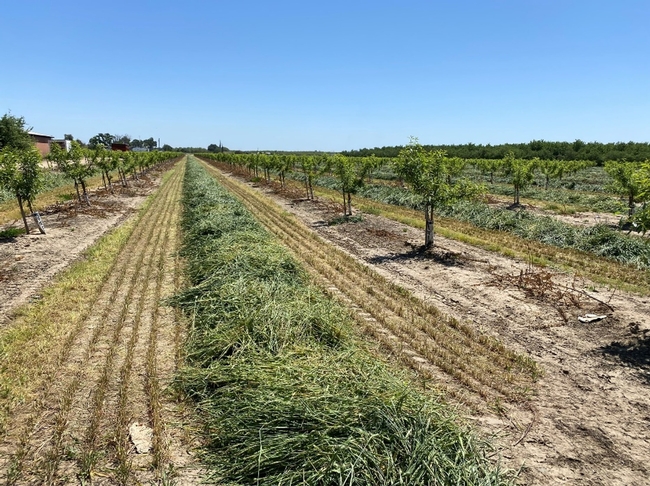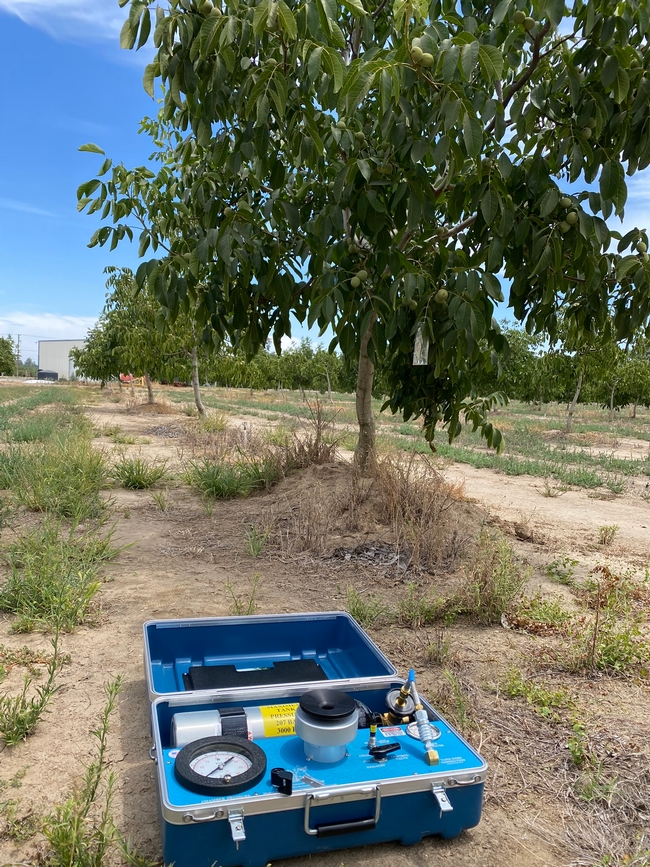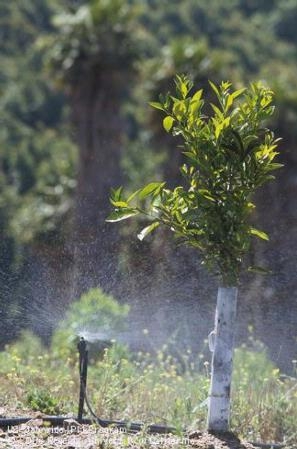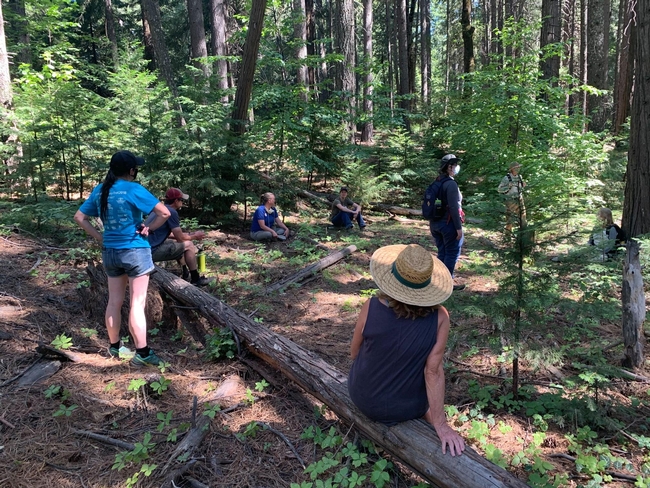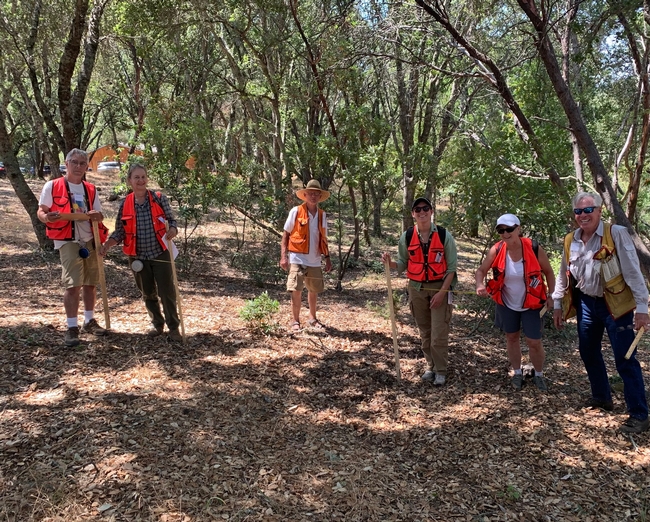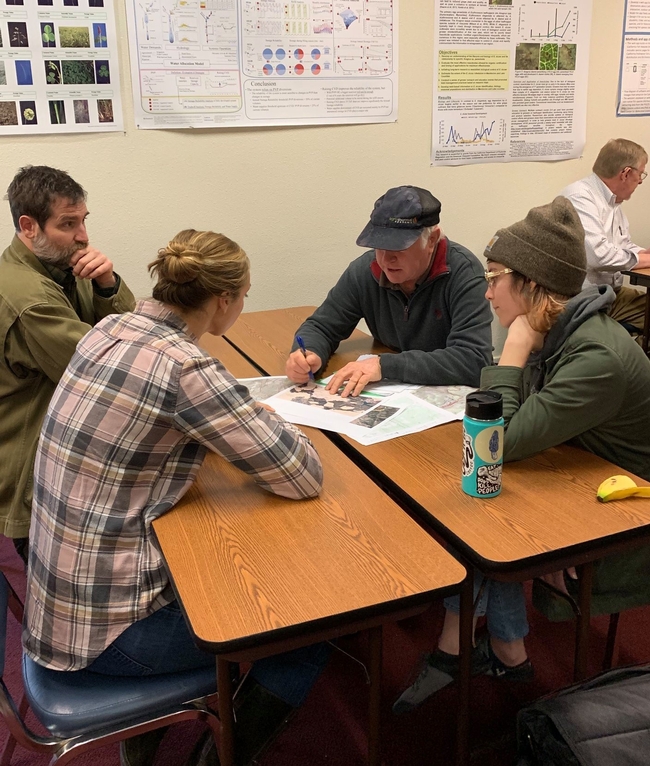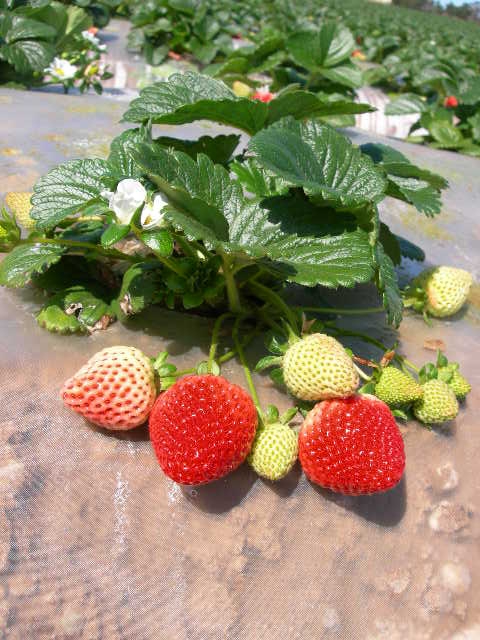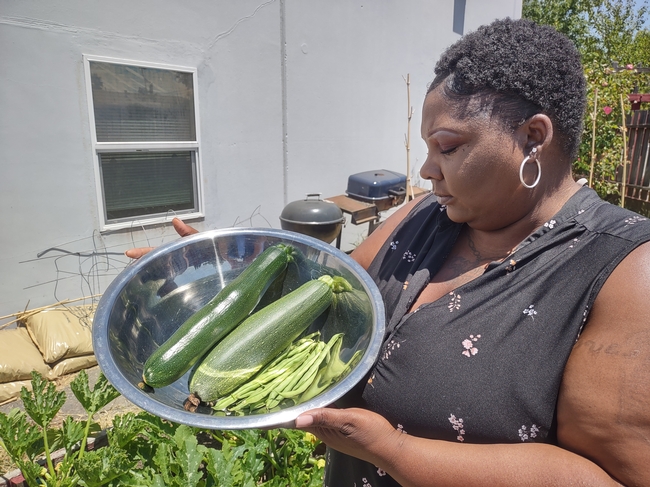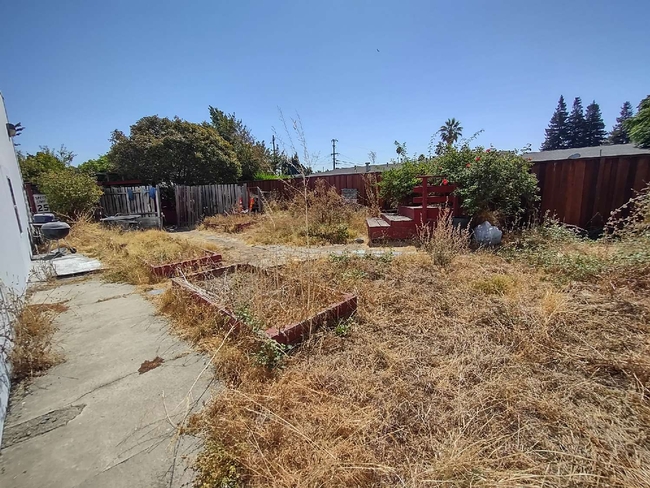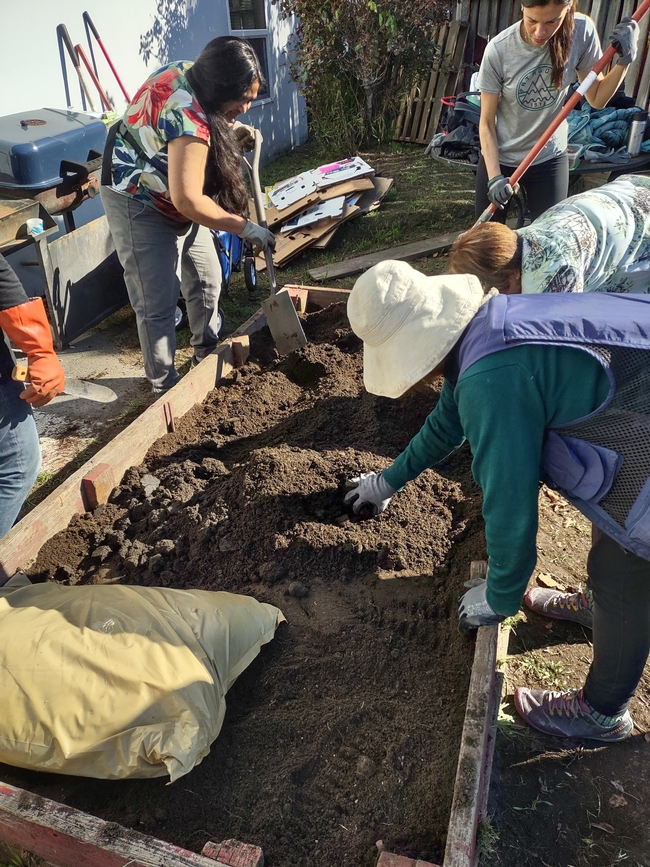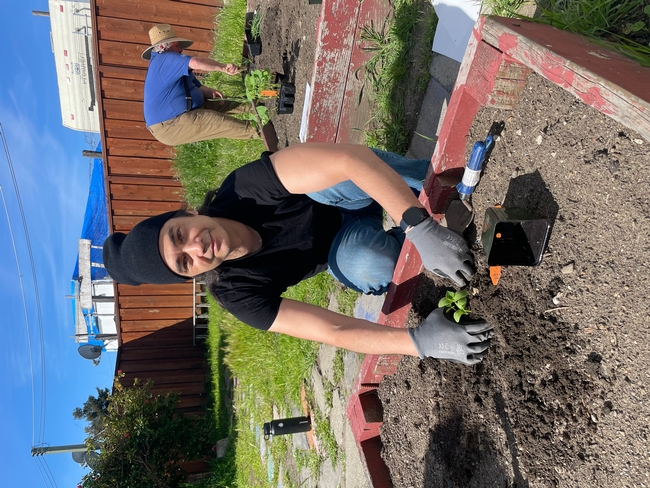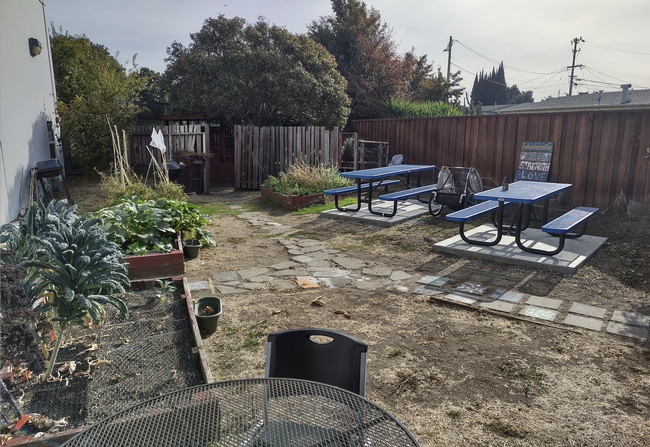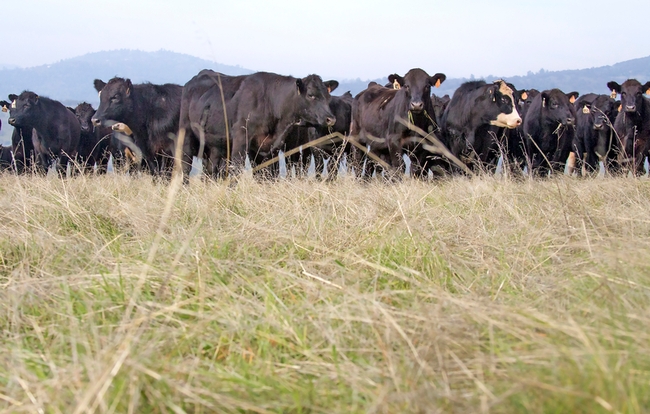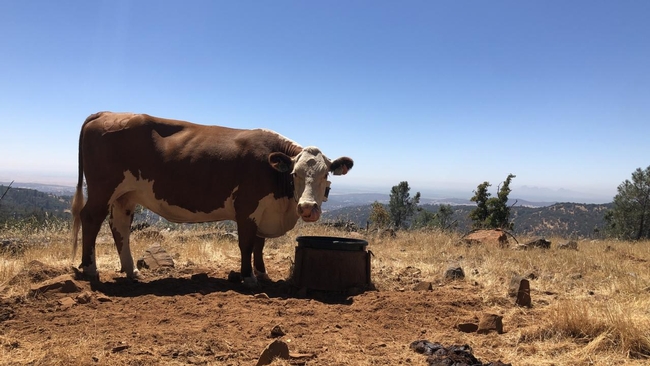UC Blogs
Young orchard water and nutrient management workshops offered in Modesto, Merced, Fresno, Bakersfield
Growers invited to discuss young almonds, pistachios, walnuts, olives and citrus orchards starting May 9
To help growers manage irrigation and nutrients for young and immature orchards, UC Cooperative Extension is offering workshops in Modesto, Merced, Fresno and Bakersfield.
The workshops will feature presentations by various experts and researchers focusing on best irrigation and nutrient management practices tailored specifically for young orchards in the San Joaquin Valley. They will cover almonds, pistachios, walnuts, olives and citrus.
“Attendees will gain insights into the irrigation and nutrient needs of young orchards, which are different from those applicable to mature orchards, and learn strategies for adjusting these practices as orchards mature,” said Moneim Mohamed, UC Cooperative Extension irrigation and soils advisor for Stanislaus, San Joaquin and Merced counties. “This knowledge aims to ensure healthier tree development, better resource use and more resilient orchards in the face of climate change.”
Growers, certified crop advisers and other agricultural professionals are encouraged to attend. Workshop attendees may request one-on-one assistance from a UCCE farm advisor.
Speakers include UCCE advisors Mohamed, Mae Culumber, Tobias Oker, and Cameron Zuber, UCCE specialist Giulia Marino, Andre Daccache of UC Davis, Charles Hillyer and Shawn Ashkan of Fresno State.
The Young Orchard Irrigation and Nutrient Management workshops will be held in four locations:
Modesto
May 9 (8 a.m.–12:30 p.m.)
UC Cooperative Extension, Room HI, 3800 Cornucopia Way
Register at https://ucanr.edu/orchardsmodesto
Merced
May 14 (8 a.m.–12:30 p.m.)
UC Cooperative Extension, 2145 Wardrobe Avenue
Register at https://ucanr.edu/orcharsmerced
Fresno
May 22 (8 a.m.–12:30 p.m.)
Fresno State, 5370 N. Chestnut M/S OF 18
Register at https://ucanr.edu/orchardsfresno
Bakersfield
June 5 (8 a.m.–12:30 p.m.)
UC Cooperative Extension, 1031 South Mount Vernon Avenue
Register at https://ucanr.edu/orchardsbakersfield
Workshops are free and include coffee breaks, lunch, workshop materials along with the presentations. Registration is required.
These workshops are supported by a grant from California Department of Food and Agriculture and sponsored by Almond Board of California, California Pistachio Research Board, WiseConn Engineering and Irrometer Company, Inc.
Connecting California’s forest landowners with California Tree School
While trees and forests are often emblematic of constancy in a fast-paced world, our state's forests are actually changing before our eyes. Since 2020, the UC ANR Forest Stewardship Education (FSE) program has been helping California's forest landowners be proactive about the inevitable shifts their forestland will experience. The Forest Stewardship and Post-Fire Forest Resilience workshop programs use an online educational format, which guide landowners through the basics of creating forest management plans and managing post-fire landscapes, respectively. Now, the FSE team is piloting a new program to engage a wider audience of forest landowners and community members passionate about trees.
This spring, the Forest Stewardship and UC ANR Fire Network teams are holding the first California Tree School, where individuals attend multiple in-person classes on the forestry topics they are most curious about. “The existing online programs are very focused on forest management plans and post-fire activity, and [Tree School] lets us tackle other topics,” said UC ANR forest and natural resources advisor Susie Kocher.
A one-stop shop for continuing forestry education
California Tree School was inspired when Forest Stewardship Academic Coordinator Kim Ingram, Post-fire Academic Coordinator Katie Reidy and Kocher attended Oregon State University Extension's Tree School event in Clackamas County, Oregon. OSU Tree School is a day-long experience comprised of classes that cover the different dimensions of forestry: constructing a house from your own timber, carbon cap and trade, and buying portable sawmills are just a small sampling of the options for attendees. OSU Tree School students ranged from forest landowners to community college students, contributing to a space which would facilitate community connections as well as learning.
Kocher described the experience as a “a great one-day, one-stop shop to keep up-to-date on what we [forest landowners and professionals] should know.” Excited by the breadth of opportunities offered at OSU's Tree School, Ingram, Kocher and Reidy were inspired to bring the format to California.
“It's our time to discuss the whole ecosystem,” noted Reidy. “Tree School is bringing in the trustworthy, reliable group of experts who can provide more information on the questions pertaining to landowners' specific goals.”
California Tree School will be offered in two locations this spring, with CA Tree School- Hopland taking place on May 4, and CA Tree School- El Dorado on June 1. Similar to OSU's Tree School, attendees are expected to be a mix of forest landowners, natural resource professionals and interested community members.
Connecting statewide professionals; personalizing forestry education
Tree School offers attendees the opportunity to focus on subjects that pertain to their specific learning needs. This personalized approach is a new foray for the Forest Stewardship team, but is something that Ingram says workshop participants have been wanting for some time.
“Our participants never think they learn enough. They are always asking for more information, and this Tree School gives us the chance to expand on things we might not have had a chance to go over in the workshop series,” remarked Ingram. Additionally, Tree School instructors had creative freedom when it came to developing their classes, from the topic to the class format. This is evident when browsing through each session's class catalog. CA Tree School attendees choose four classes to attend, meaning they can build their first burn pile, understand the ins and outs of regional wildlife, paint outdoors and learn how to aid statewide reforestation efforts all in one day.
“I felt that Tree School created a sense of trust around complex topics,” noted Reidy about her experience last year in Oregon. For CA Tree School, the Forest Stewardship team aims to do the same. This meant recruiting from throughout the UC ANR network and other organizations, including CALFIRE and CARCD (California Association of Resource Conservation Districts), to bring trusted voices to the community.
“What's exciting about Tree School is that we are bringing natural resource professionals from all around to engage everyone at the same time, and all in one place,” noted Ingram.
The team is excited to see all the connections that will be made between community members and professionals during this pilot year, and “if this is successful and we can bring it back next year,” commented Kocher, “we are definitely interested in partnering with more people and expanding our outreach.”
Making CA Tree School an in-person experience was important to the team, as much of the education is hands-on. Additionally, Kocher sees enhanced potential for building personal connections: “In person, you have this opportunity for people to identify as part of a community,” noted Kocher, “So I'm excited for people to hang out with each other.”
Encouraging an informed community
“You can't separate the emotional from the physical, and there are a lot of topics in forestry like wildfire and economics that can be a bit of a downer,” said Ingram. “I'm excited to help create a positive learning environment, and one that encourages folks to turn to UC Cooperative Extension for these resources.”
“Our main goal here is to get science out there,” concurred Reidy. “The more exposure people have to science, the more confident they feel in themselves and their wants and needs.”
New UC study estimates costs for growing strawberries on the Central Coast
A new study that can help growers and other readers estimate costs and potential returns for growing strawberries on California's Central Coast was recently released by UC Agriculture and Natural Resources, UC Cooperative Extension and the UC Davis Department of Agricultural and Resource Economics.
“This study provides growers with a baseline to estimate their own costs, which can help when applying for production loans, projecting labor costs, securing market arrangements, or understanding costs associated with water and nutrient management and regulatory programs,” said Brittney Goodrich, UC Cooperative Extension specialist and study co-author.
The cost study models a management scenario for a 50-acre farm, 45 acres of which are planted to strawberries, located in Santa Cruz, Monterey or San Benito counties. The remaining acres are for the irrigation system, roads and buildings. The study describes the cultural practices used in strawberry production and harvest, including land preparation, soil fertility and pest management, irrigation and labor needs.
The 19-page study shows costs for each operation, material inputs and costs, and cash and non-cash overhead costs in a variety of formats for one production and harvest cycle. A ranging analysis is also included and shows potential profits or losses over a range of prices and yields.
The new study, titled “2024 Sample Costs to Produce and Harvest Strawberries” can be downloaded from the UC Davis Department of Agricultural and Resource Economics website at https://coststudies.ucdavis.edu.
For a detailed explanation of the assumptions and calculations used to estimate the costs and potential returns for each crop, readers can refer to the narrative portion of each study.
For more information, contact Mark Bolda, University of California Cooperative Extension farm advisor, at mpbolda@ucanr.edu, or Jeremy Murdock in the Department of Agricultural and Resource Economics at jmmurdock@ucdavis.edu.
Sample cost of production studies for many other commodities grown in California are also available at https://coststudies.ucdavis.edu.
Homeless people cultivate food, better health while gardening in Alameda County
Fresh fruits and vegetables are essential to a healthful diet, but it's hard to keep perishable foods on hand if one doesn't have a refrigerator or a home. To enhance the health of homeless people, the CalFresh Healthy Living, UC Cooperative Extension team in Alameda County has partnered with the South County Homeless Project to grow fresh produce for people staying at the emergency housing in Hayward.
For the past seven years, CalFresh Healthy Living, UCCE Alameda has been delivering nutrition lessons to residents of the South County Homeless Project, part of Building Opportunities for Self Sufficiency. The classes include Rethink Your Drink, Food Safety, Making Every Dollar Count, Eat Healthy Be Active Community Workshops, and Fresh from the Garden.
The South County Homeless Project facility houses 24 people for up to a year. With the help of the CalFresh Healthy Living, UC Cooperative Extension team, its existing garden was refurbished and redesigned. The large outdoor garden behind the facility offers therapeutic gardening opportunities to residents and provides food for their meals.
"I love the garden and when the cook cooks the vegetables, they taste amazing,” said one resident. “I am thankful for this garden and for having the CalFresh Healthy Living team.”
At one time, South County Homeless Project's backyard featured a flower garden. After years of neglect, weeds overtook the garden.
In 2022, CalFresh Healthy Living, UCCE Alameda proposed getting residents involved in growing food by resurrecting the garden with edible plants.
“Not only could we continue to engage residents in nutrition education classes, but we could also work together to reinvigorate their neglected garden,” said MaxFairbee, nutrition educator withCalFresh Healthy Living team,UCCE Alameda.
More than 15 varieties of herbs and vegetables planted
Residents and staff set out to replace the weedy beds with a vegetable and herb garden.
“We worked with South County staff and residents on the design, clean up, planting, harvesting and ultimately incorporating food from the garden into the kitchen for residents to enjoy the fruits of their labor,” Fairbee said.
For gardening expertise and support, Fairbee enlisted the UC Master Gardeners of Alameda County's Community Garden Team to help. While the CalFresh Healthy Living, UCCE staff continued providing nutrition classes, the UC Master Gardener volunteers trained the residents on the basics of gardening.
In April, after heavy rains, the group planted 50 seedlings, half donated by the UC Master Gardeners. They planted two varieties of lettuce,arugula, four varieties of tomatoes, zucchini, kale, onions, cucumbers, green beans, Swiss chard, kale, basil, cilantro, tarragon, thyme, parsley, rosemary, oregano and mint.
From garden to table
“In May, we harvested lettuce and in June, we harvested green beans, cucumbers, kale and onions,” Fairbee said.
The fresh vegetables and herbs were used to prepare salads, sandwiches and pasta dishes for the residents. Fairbee and the other educators have also used the fresh produce for cooking demonstrations and tastings as part of their Fresh from the Garden class.
"We have been able to use many of the veggies as sides or to go in the salad," said one of the South County Homeless Project cooks.
"One of the chefs used the zucchini in the pasta sauce, it was so good! I didn't really know you could use it that way!" said a resident.
After tasting summer squash andgazpacho made with tomatoes from the garden, a South County resident namedSelina said, "I was surprised how good the raw summer squash tasted and how the flavor was different after it was cooked. I'll definitely be adding more zucchini to my plate."
Challenges to keeping the garden going
To keep the garden healthy, they faced competition with plant-chewing snails, slugs and aphids and cats digging in the soil. Because the water source is over 200 feet from the garden, they run a long hose across the main path, along the parking lot to water the plants, then unhook the hose and stash it indoors after each use so that it won't get stolen.
Another challenge of maintaining the garden is getting enough residents and staff to volunteer to work on it.
“Although staff are supportive of the garden, none actually have time to work in the garden,” Fairbee said.
The residents harvest, wash and store the produce in the kitchen. Only four to six of the 24 residents are typically interested in working in the garden, pulling weeds and protecting the plants from pests – most are focused on getting a new job and a home. South County residents usually leave the temporary housing within a few months.
For more consistent garden maintenance, Fairbee is looking to other community groups for volunteers. He is also hoping to persuade the county government to install a water spigot close to the garden so they can install drip irrigation to water the garden.
“We'd like to work with the UC Master Food Preservers to teach residents how to preserve herbs and vegetables,” Fairbee said.
He hopes South County Homeless Project residents will continue gardening in their new homes to grow fresh vegetables so they can enjoy a more nutritious diet and better health.
Beyond the fresh food, the South County Homeless Project residents and staff enjoy the ambience of the garden.
"It's really nice to go back there and just sit, it's really peaceful," said one staff member.
A resident added, "(The garden) relaxes me from stress. I love the garden."
Understanding cattle grazing personalities may foster sustainable rangelands
Matching herds to landscape can support animal growth and ecological needs
Not all cattle are the same when it comes to grazing. Some like to wander while others prefer to stay close to water and rest areas.
Recognizing those personality differences could help ranchers select herds that best meet grazing needs on rangelands, leading to better animal health and environmental conditions, according to a new paper from the University of California, Davis, published in the journal Applied Animal Behaviour Science.
“Cattle can actually be beneficial for the rangelands,” said lead author Maggie Creamer, who recently earned her Ph.D. in animal behavior at UC Davis. “Vegetation in rangelands actually need these kinds of disturbances like grazing.”
Ranchers can add elements to the rangeland such as water, mineral supplements and fencing to influence where cattle graze, but little research has been done on how those efforts affect individual cows. Considering personalities could save money.
“If you're spending all this money to add a management tool in order to change the distribution of your animals, that's a huge cost to ranchers,” said Creamer. “Thinking about other tools, or selecting certain animals with these grazing traits, might be a better way to optimize the distribution on rangeland rather than spending a bunch of money for something that may ultimately not pan out for all your animals.”
Effects of grazing
Livestock graze on an estimated 56 million acres in California, and healthy rangelands host native vegetation and animals, foster nutrient cycling and support carbon sequestration.
Uneven grazing can degrade water quality, soil health and habitats. Optimizing grazing — including the even spread of cow pies — can improve the ecosystem while also reducing fuel loads for wildfires.
To better understand individual grazing patterns, researchers went to the UC Sierra Foothill Research and Extension Center in Browns Valley and tracked 50 pregnant Angus and Hereford beef cows fitted with GPS collars.
The research
The cattle, which were tracked from June to August over two years, had access to 625 acres of grasslands and treed areas ranging in elevation from 600 to 2,028 feet. In the second year, a new watering site was added at a higher elevation.
Across the two years, the cows showed consistent and distinct grazing patterns even when water sources changed. Age and stage of pregnancy did not affect patterns, though cattle tended to clump near water and rest sites on hotter days.
The cows that ventured into higher elevations and farther from watering sites had more variability in their grazing patterns than those that stayed at lower elevations near water. That suggests it may be harder for non-wanderers to adjust to some landscapes.
“Thinking about the topography of your rangeland and your herd of cows can benefit both the animals and the sustainability of the land,” said Creamer, who next month begins work as a postdoctoral scholar in North Carolina.
Gauging personalities
Keying in on personality type may sound difficult, but the researchers also found some clues as to how to pinpoint the wanderers and homebodies. Unlike cattle at feedlots, the breeding cow population, especially on rangelands in California and other western states, live largely “wild” lives and are rarely handled, save for vaccinations and weaning.
Research due to be published later this year found that paying attention to individual cow reactions during those events can help determine personalities. The cows that appeared more passive during those handling interactions tended to be nomadic.
“We found that you can maybe predict those hill climbers if you kind of look at how they act when the veterinarian or rancher handle them,” said senior author Kristina Horback, an associate professor in the Department of Animal Science at UC Davis.
Informing practices
For ranchers, the findings could be invaluable, said Dan Macon, a livestock and natural resources Cooperative Extension advisor in Placer and Nevada counties for UC Agriculture and Natural Resources.
“Any time we can improve our understanding of cattle behavior, particularly at the individual level, it can improve how we handle livestock and manage the landscape,” he said.
Macon said that during the recent drought, it was hard to get cattle into higher country, but if ranchers could have selected the nomads, it may have saved money in terms of ranch labor and other efforts.
“If you ask a rancher who has been attentive to their cattle over many years, they know the personalities,” Macon said.
For Creamer and Horback, the research opens new doors into understanding herd behavior and dynamics, one that could be a cheaper alternative to high-tech solutions.
“Animal science tends to look overlook the mind of the animal when searching for solutions to challenges,” Horback said. “It's always been a direct line to genetics for immunity or nutrition, but nothing about the mind of the animal. And that's such a loss. There's so much we can learn from behavior in the end.”
The Russell L. Rustici Rangeland and Cattle Research Endowment supported the research.
This article was first published on the UC Davis News site.


